北欧绿色邮报网报道(记者陈雪霏)--第二届世界互联网大会在中国浙江乌镇召开。请欣赏乌镇美图。
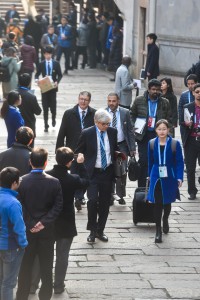
北欧绿色邮报网报道(记者陈雪霏)--12月3日,随着最后一片重达41吨加劲梁的精准吊装,湖南张家界大峡谷玻璃桥钢箱梁成功合龙。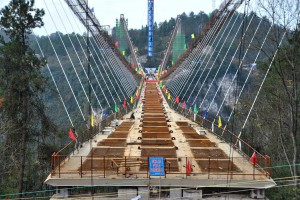 毛主席诗词:
毛主席诗词:
|
水调歌头·游泳(1956年6月)
|
||
才饮长沙水, 风樯动, 这首词最早发表在《诗刊》一九五七年一月号。 |
北欧绿色邮报网报道(记者陈雪霏)--据新华社消息,12月3日,在泾县昌桥乡孤峰村国民油布伞厂,工人在晾晒伞。

在安徽省泾县昌桥乡孤峰村有一家油布伞厂,由于传承传统制作技艺,产品受到国内外市场欢迎,油布伞已成为当地的一张名片。
 据该厂负责人郑国民介绍,孤峰油布伞制作分选材、量尺寸、刨竹节和分片、打孔、排竹、套伞头、伞骨与伞头相连、制伞面、上布、刷桐油、盖章或署名、晾晒等12道工序,因选料要求高,纯手工制作复杂,操作要领全凭多年的实践经验,一把油布伞从材料到成品一般需一周时间。
据该厂负责人郑国民介绍,孤峰油布伞制作分选材、量尺寸、刨竹节和分片、打孔、排竹、套伞头、伞骨与伞头相连、制伞面、上布、刷桐油、盖章或署名、晾晒等12道工序,因选料要求高,纯手工制作复杂,操作要领全凭多年的实践经验,一把油布伞从材料到成品一般需一周时间。
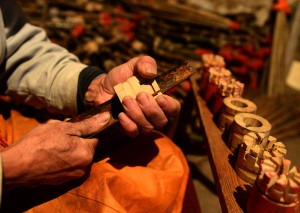
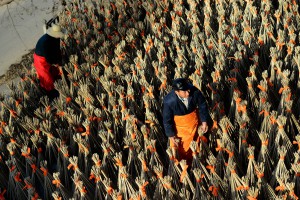
作为宣城市级非物质文化遗产传承人,郑国民说他们已经为油布伞的传统制作工艺申报了省级非物质文化遗产项目。
郑国民还打算在油布伞的基础上研发庭院伞,进一步提高油布伞的观赏性和艺术性,将油布伞的传统技艺更好地传承下去。

STOCKHOLM, Dec. 7 (Xinhua) — Artemisinin, the most effective drug that combat malaria today is “a gift from Traditional Chinese Medicine (TCM) to the world”, said Tu Youyou, in her presentation at Nobel Lectures in Physiology or Medicine in Stockholm on Monday.
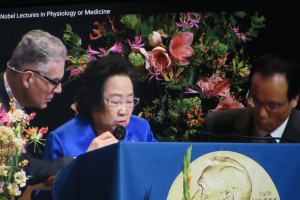 In the half-hour-long lecture at Karolinska Institutet in central Stockholm with full participation of a thousand audience, Tu detailed a vivid story in the 1970s of how a group of Chinese researchers despite various challenges successfully developed a cure to treat malaria.
In the half-hour-long lecture at Karolinska Institutet in central Stockholm with full participation of a thousand audience, Tu detailed a vivid story in the 1970s of how a group of Chinese researchers despite various challenges successfully developed a cure to treat malaria.
Tu won 2015 Nobel Prize in Physiology or Medicine for her discoveries concerning a novel therapy against Malaria, artemisinin.
Drawn from valuable research experiences in developing artemisinin, Tu believes “Chinese medicine and pharmacology are a great treasure-house”, which “should be explored and raised to a higher level.”
“Since ‘tasting hundred herbs by Shen Nong’, China has accumulated substantial experience in clinical practice, integrated and summarized medical application of most nature resource over the last thousands of years through Chinese medicine,” Tu said.
“Adopting, exploring, developing and advancing these practices would allow us to discover more novel medicines beneficial to the world healthcare,” Tu stressed.
“The sun along the mountain bows; The Yellow River seawards flows; You will enjoy a grander sight; By climbing to a greater height!” Tu quoted a poem from China’s Tang Dynasty in her speech.
“Let’s reach to a greater height to appreciate Chinese culture and find the beauty and treasure in the territory of traditional Chinese medicine!” She said.
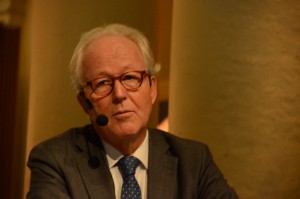 “I enjoyed it very much, it’s fascinating story when she recalled how she went back to TCM and found this method that’s so very important for mankind,” Lars Heikensten of the Nobel Foundation told Xinhua, “it’s truly enjoyable moment.”
“I enjoyed it very much, it’s fascinating story when she recalled how she went back to TCM and found this method that’s so very important for mankind,” Lars Heikensten of the Nobel Foundation told Xinhua, “it’s truly enjoyable moment.”
Despite Tu presented in Chinese and had her English version in PPT on background screen, Jan Lindsten, emeritus professor and former Secretary-General of Nobel Committee for Physiology or Medicine, understood and enjoyed very well.
“She made a very mature comparison between modern pharmacology and Traditional Chinese Medicine (TCM), which I think is extremely important and well worth to pursue in future to find treasure from TCM in developing new drugs,” Lindsten told Xinhua.
“I am quite sure we will have future medicine comes from nature!” Birgitta Rigler, head of the Rehabilitation Clinic in Dandryd’s Hospital in Stockholm, told Xinhua.
“Chemical industry may be faster in developing new drugs, but perhaps nature-based things are more durable,” she said. Enditem
BEIJING, Dec. 8 (Xinhua) — It would be unwise, especially during an economic slowdown, for China to solely rely on the service sector, as it belittles the significance, and potential, of its industry.
While it is true that the service sector is outperforming industry in terms of the share of GDP, industry remains the backbone of the economy.
After all, services are dependent on the development of the industrial and agricultural sectors. To underestimate this relationship would result in an unsustainable economic model.
Manufacturing, especially the processing trade, was the main fuel firing China’s rapid expansion for the past decades.
Given the size of the economy, over-dependence on exports and credit expansion is no longer tenable. China needs to shift to a more consumption- and service-driven growth model to sustain growth, albeit at a slower rate, over the next decade and beyond.
The aim of such a transition, however, is to make the traditional industrial sector more competitive, rather than less significant.
To this end, programs such as “China Manufacturing 2025” and “Internet Plus,” aim to support the upgrading of the industrial sector by focusing on modernization and innovation, and to rebrand China from “the factory of the world” to a premier industrial power.
While the need to maintain its industrial might is influenced by its own development story, there are untold number of lessons to be drawn from developed nations.
The United States is one such example. Once the world’s largest industrial producer, in the 1980s it started to out-source manufacturing. The service sector not only flourished but actually replaced manufacturing as the backbone of the economy, eventually accounting for as much as 70 percent of the economy. Without the support of a real economy, it was only a matter of time before the bubble burst, triggering the 2008 mortgage crisis that spiralled into the worst economic disaster since the Great Depression.
The United States is now trying to claw back the lost advantages of its industrial sector. This time, however, by focusing on innovation it aims to create a stronger sector that is able to compete globally.
Alexander Hamilton, one of America’s founding fathers, once said, “not only the wealth, but the independence and security of a country, appear to be materially connected with the prosperity of manufacturers.” That judgement still holds true for today’s China. Enditem
BEIJING, Dec. 8 (Xinhua) — To ensure a medium-high level of economic growth for the next five years, China has moved to foster new growth engines as old ones lose steam.
China’s exports dropped by 3.7 percent in November, the fifth straight month of decline, to 1.25 trillion yuan (195 million U.S. dollars), customs data showed Tuesday.
In recent years, old growth engines, including exports and investment, lost momentum partly due to weak demand at home and overseas. The country’s quarterly GDP growth slowed to a six-year low of 6.9 percent in the third quarter of this year.
In the next five years, the country’s annual growth rate should be no less than 6.5 percent to realize the goal of doubling the GDP and per capita income of 2010 by 2020.
To attain that goal, the government must cultivate new growth engines to bolster growth in the next five years.
EMERGING INDUSTRIES
As traditional industries including steel, coal and cement sectors are facing excessive capacity, China is moving to tap the potential of new industries with bright prospects.
A proposal for formulating the country’s 13th five-year plan unveiled last month said that China will step up researches on core technology concerning the new generation of telecommunications, new energy, new material and aviation, and support the development of new industries, including energy conservation, biotechnology and information technology sectors.
In Changzhou, a city in eastern China’s Jiangsu Province, there are more than 50 companies producing graphene, a new material that widely used in high-end equipment manufacturing, forming a national level production base for the material. Products made by Changzhou Tanyuan Technology Co. are used in smartphones. The company’s sales have risen from 6 million yuan to more than 200 million yuan in only three years.
Qi Chengyuan, head of the high-tech division of the National Development and Reform Commission (NDRC), said China will turn new strategic industries into major driving forces for economic growth in the next five years.
The country should form five new pillar industries that each have a potential of becoming a 10 trillion yuan industry, including information technology, bioindustry, green industry, high-end equipment and material, as well as the creative industry, Qi said.
ENTREPRENEURSHIP AND INNOVATION
New impetus must also come from the government’s emphasis on mass entrepreneurship and innovation.
In the first three quarters, China’s newly registered companies rose 19.3 percent to 3.16 million, as the country pushed for easier registration to promote innovation.
Innovation is the most important impetus for China’s growth, according to the proposal for formulating the 13th five-year plan.
A good example is the strong growth in Shenzhen, a national demonstration zone for independent innovation. In the first 10 months, the proportion of R&D investment in Shenzhen’s regional GDP was more than 4 percent, nearly doubles the national average.
The city’s economic growth stood at 8.7 percent in the first three quarters, higher than the country’s growth of 6.9 percent in the same period.
 The Shenzhen-based Huawei Technologies Co., Ltd. has set up 16 overseas R&D institutions and owns a total of 76,687 patents, said its CEO Ren Zhengfei.
The Shenzhen-based Huawei Technologies Co., Ltd. has set up 16 overseas R&D institutions and owns a total of 76,687 patents, said its CEO Ren Zhengfei.
The company realized a sales volume of 288 billion yuan last year. Ren forecast that the company will more than double that sales figure by 2019 on the back of constant innovation.
Song Weiguo, researcher with the Chinese Academy of Science and Technology for Development, said that technological innovation will provide greater impetus for growth in the next five years.
REFORMS ON SUPPLY SIDE
Structural reforms on the supply side will lend more steam to sustainable growth, President Xi Jinping said last month at a meeting of the Central Leading Group for Financial and Economic Affairs.
Xu Lin, head of the NDRC’s planning division, said reforms on the supply side, which means sustainable growth instead of short-term demand management, is necessary for cultivating new growth impetus.
An important aspect of supply side reforms is government efforts to streamlining administrative approvals and delegating power to lower levels.
From early 2013 to the end of September 2015, the central government has canceled or delegated 586 kinds of administrative approval.
In the economic and technological development zone of Nanning, Guangxi Zhuang Autonomous Region, the bureau in charge of administrative approvals cut the red tape and reduced the time needed for getting an approval from more than 300 days to 20 days.
On the supply side, China should maintain structural tax reductions to boost the service and advanced manufacturing sectors and support small enterprises, and push forward entrepreneurship and innovation, Premier Li Keqiang said earlier this month.
China will keep cutting red tape to foster emerging industries and speed up the overhaul in traditional industries to improve efficiency, Li said.
With new impetus from China’s reform pushes, the country will be able to realize an average annual growth of 6.5 percent in the next five years, said Yu Bin, researcher with the Development Research Center of the State Council. Enditem
BEIJING, Dec. 11 (Xinhua) — Nearly 20 provincial governments in China have rolled out their local development plans for the 13th Five Year Plan period from 2016 to 2020, with their focus on the “Belt and Road” construction, the Shanghai Securities News reported on Friday.
Under their development plans, they attach great importance to infrastructure construction in transportation industry and construction of industrial parks.
— Focus on transport infrastructure
Chinese local governments will give priority to transport infrastructure when promoting the “Belt and Road” initiative.
For example, Shaanxi province will be guide by construction of a logistics center to build a seamless transport network in 2016-2020. Guangxi Zhuang Autonomous Region also said in its proposal to the 13th Five Year plan that it will build a convenient and efficient railway network, expressway network, water transport network, airline network and information network with the Association of Southeast Asian Nations (ASEAN) and neighboring provinces.
It is worth noting that in the land transportation field, the China-Europe express railway will play an increasingly important role in “going global” of Chinese goods.
As a core area of the 21st Century Maritime Silk Road, Fujian province plans to build important airline hubs for Southeast Asia and advance construction of a regional port-shipping system and communication network facilities, to smoothly connect the land channel of the Silk Road Economic Belt and form a passage to sea for central and western China’s opening-up.
Jilin province in its 13th Five Year plan noted that it will actively explore the Arctic Ocean ship routes linking the Europe and the U.S.A., steadily operate international rail and water transportation lines linking Japan and South Korea, and further expand its outward transport lines.
Meanwhile, Tianjin will make full use of its unique geographic location advantages to vigorously promote port and maritime strategic cooperation. It will develop cross-border logistics through three land ports, like the Khorgos Port and develop maritime transport through intensive ship routes and shipping flights.
Zhejiang province announced to promote construction of a marine economic development demonstration zone and Zhoushan Islands New Area, and build a port economic circle covering the Yangtze River Delta, influencing the Yangtze River economic belt and serving the “Belt and Road” initiative.
In addition, Gansu province decided to invest more than 800 billion yuan from this year to build more than 70,000 km of roads and railways in six years.
— Efforts in industrial park construction
Industrial park construction is also a focus in the 13th Five Year plans of the provinces.
Xinjiang Uygur Autonomous Region said that it will accelerate construction of core areas in the Silk Road Economic Belt, develop high-level open economy, and quicken the pace to build the Kashgar and Khorgos economic development zones and comprehensive bonded zones.
Because of the “Belt and Road” initiative, ALaShankou has invested a lot in infrastructure, promoting rapid development of its comprehensive bonded zone, said Pan Zeming, deputy director of the ALaShankou Comprehensive Bonded Zone.
In its 13th Five Year plan, Fujian province made it clear to promote construction of important commodity export bases, commodity markets and commerce and trade parks and explore mutual establishment of industrial parks with Southeast Asian countries.
Chongqing municipality pointed out that it will actively participate in construction of overseas industrial agglomerations and economic and trade cooperation zones.
Shaanxi province said it will encourage and support competent enterprises to go abroad for transnational operation and strategic acquisitions and build Shaanxi industrial parks overseas especially in Central Asia and Africa. Meanwhile, it will also build economic cooperation zones and high-tech industrial parks to attract investments of the transnational companies and globally leading enterprises and persuade them to build regional headquarters and branches in Shaanxi.
“Industrial park is an important method for “going global” of Chinese enterprises. It is a new form for Chinese enterprises to build “Belt and Road” and also a way to change simple cargo transportation”, said Hu Zheng, chief representative of the Central Asia Representative Office of the China Merchants Group.
Since the beginning of the year, China has quickened its pace of building industrial parks along the “Belt and Road” countries.
Data of the Ministry of Commerce shows that so far, China has already built 118 economic and trade cooperation zones in 50 countries, of which 77 zones are located in 23 countries along the “Belt and Road”. Enditem
BEIJING, Dec. 11 (Xinhua) — With China’s 13th Five-year Plan beginning next year, the focus of reform will start with addressing the quality of ordinary people’s lives.
At the latest meeting of the central leading group for comprehensively deepening reform on Wednesday, the leadership decided to implement the five development ideas put forward at the plenary session of the Communist Party of China (CPC) Central Committee in late October: innovation, coordination, sharing, environmental protection and openness.
At the beginning of the 13th Five-year Plan, efforts need to be “focused on building a moderately prosperous society,” said a statement issued after Wednesday’s meeting.
The group approved several reform measures, one of which is that unregistered citizens are to be given household registration permits known as “hukou,” a crucial document entitling them to social welfare.
China has around 13 million unregistered people, one percent of the entire population. They include orphans and second children born illegally during the period of strict enforcement of the one-child policy, the homeless and those who have yet to apply for one or who have simply lost theirs. Those parents who violated family planning policy often refrained from getting hukou for their children to avoid fines.0 “It is a basic legal right for Chinese citizens to register for hukou. It is also a premise for participation in social affairs, to enjoy rights and fulfill duties,” the statement said.
Wan Haiyuan with an institute of macro-economics of the National Development and Reform Commission said the difficulty lies not in hukou itself, but in related matters such as healthcare, health insurance and education.
In China, various social benefits such as medical insurance and access to basic education are based on this permit and are supposed to be in line with long-term places of work and residence.
Many people without household registration have moved to cities and become tramps. According to Wan, their birth certificates might have been lost and authorities must address this issue. Those who have come to China to seek asylum should also be taken into consideration, as they are permanent residents, despite their lack of Chinese nationality.
Education is also central to plans for the next five years, said Zhang Li, director of the Ministry of Education’s development center. The reform meeting statement declared that education should advance innovation-driven development and serve the objectives of the Belt and Road Initiative.
Zhang added the statement showed that opening up in education should take the concepts and experience of developed countries as reference.
The meeting decided to integrate basic medical insurance for urban employees and the new rural cooperative medical scheme, creating a unified basic health insurance system.
Currently China has three separate medical insurance schemes — basic medical insurance for urban employees; the new rural cooperative medical scheme; and basic medical insurance for city dwellers not covered by the first two schemes, mainly the young or unemployed.
The three schemes have been perceived as unequal for a long time, as the benefits in urban areas are much greater than those in rural parts of the country.
“Even members in one family may have different health insurance,” said Meng Qingyue, a professor in health economics with the Peking University. “The integration of different medical insurance schemes is a must for achieving equal access to basic health care for every one.”
Another measure is the reform of government’s “power list.” Since the 18th National Congress of the CPC in late 2012, administrative powers have been streamlined and delegated, with hundreds of items abandoned.
Ma Qingyu of the Chinese Academy of Governance said the power and responsibility list system can clarify responsibilities of different departments and prevent them from shirking their responsibilities or taking responsibilities that are not rightfully theirs.
“It will make the border between public powers and private rights more clear,” said Ma. Enditem
BEIJING, Dec. 8 (Greenpost) — It is expected that during an upcoming key economic meeting Chinese officials will introduce measures to cut housing inventories.
De-stocking the property market will likely be discussed at the upcoming Central Economic Working Conference, which sets economic targets for the coming year, a source told China Business News.
The measures are not expected to boost the real estate market nor set quantitative de-stocking targets for specific regions.
“The most important thing is to reactivate the property sector to help with its liquidity,” the source said.
The housing market experienced a downturn in 2014 due to weak demand and a supply glut. This continued into 2015, with both sales and prices falling, and investment slowing.
According to data from the National Bureau of Statistics, the unsold home inventory hit a record 686.3 million square meters by the end of October, up 17.8 percent from the previous year.
Officials have already showed resolve to address the country’s housing woes. Destocking the property market will be one of the government’s main tasks, President Xi Jinping told a meeting of the Central Leading Group for Financial and Economic Affairs in November.
Premier Li Keqiang also told a cabinet meeting that the government should overhaul China’s household registration system to encourage more rural residents to settle in cities and boost house sales.
Besides existing stimulus measures such as cutting interest rates and easing deposit requirements, measures such as transforming commercial housing into affordable housing are also expected next year, the source said. Enditem
BEIJING, Dec. 8 (Greenpost) — China should accelerate construction to raise the weight of clean energy like natural gas, nuclear power, hydropower, wind power and solar energy during the 13th Five-year Plan period (2016-2020), according to an article by Zhou Dadi, a senior researcher at Energy Research Institute under the National Development and Reform Commission, carried on Shanghai Securities News on Tuesday.
Zhou said that energy investment structure of the country should be optimized under state-level planning, industrial self-discipline construction and regional arrangement. China should reduce coal mining and construction of coal-fired power plants and develop low carbon energy instead of high carbon energy, the expert noted.
Source Xinhua, Editor Xuefei Chen Axelsson
BEIJING, Dec. 8 (Greenpost) – The high energy nickel carbon super cell for electric car is expected to realise mass production before the end of this year.
The super cell, developed by Zhongke Taineng Science and Technology Development Co., Ltd, can be charged and discharged for more than 5,000 times with each charging fulfilling the energy demand for 200-300 kilometers’ driving.
The super cell has been used safely and worked steadily for three years and nine months in buses of three lines in Zibo in Shandong province. Enditem
Source Xinhua, Editor Xuefei Chen Axelsson
BEIJING, Dec. 9 (Xinhua) — China removed 1.17 million high-emission vehicles from roads nationwide in the first 11 months of this year, the Ministry of Environmental Protection announced on Wednesday.
The figures showed that almost all high-emission commercial vehicles registered before the end of 2005 had been pulled from the roads, a target set in March, according to the ministry.
To accelerate the removal of targeted vehicles, the ministry has filed monthly reports briefing the public on the latest developments in each provincial region since July. Enditem
北欧绿色邮报网--中国著名医药学家诺奖得主屠呦呦12月7日在她的诺贝尔演讲中以唐代著名诗人王之涣的诗篇《登鹳雀楼》结尾,号召大家要更上一层楼。同一首诗,不同人有不同的翻译。下面请欣赏诺奖版本。
On the stork tower1
The sun along the mountain bows;
The Yellow River seawards flows;
You will enjoy a grander sight,
By climbing to a greater height.
白日依山盡,Bái rì yī shān jìn,[white] [sun] [on] [mountain] [finish]The white sun sets behind the mountains,
黃河入海流;Huánghé rù hǎiliú;[Yellow] [River] [enter] [sea] [flow]and the Yellow River flows into the sea.
欲窮千里目,yù qióng qiānlǐ mù,[want] [furthest] [thousand] [mile] [eye]To see a thousand mile view,
更上一層樓。gèng shàng yì céng lóu.[more] [ascend] [one] [floor] [tower]go up another floor.
鄙人版本
Climbing on Stork Tower
Wang Zhihuan
The sun sets alongside the mountains,
The Yellow River flows towards the sea.
You like to see much farther,
You have to climb up higher.
笔者以为还是诺奖版本翻译得好,简练,意译,有诗意。
BEIJING, Dec. 10 (Xinhua) — Current fluctuations of the renminbi (RMB) exchange rate should not be seen as a sign of devaluation, China’s foreign exchange regulator said Thursday.
The market is insufficiently tolerant of RMB exchange rate fluctuations, Wang Chunying, an official of the State Administration of Foreign Exchange (SAFE), told a press conference.
Wang said more consideration should be taken of the RMB multilateral exchange rate against a basket of currencies and its long-term trend.
The central parity rate of the RMB, or the yuan, weakened by 96 basis points to 6.4236 against the U.S. dollar on Thursday, the lowest in four years, according to the China Foreign Exchange Trading System.
This volatility is the expected result of RMB interest rate marketization, which reflects both domestic demand and supply and changes in the global financial market, said Wang Yungui, another SAFE official. He added that given China’s stable economic and market fundamentals, there is no basis for the yuan’s long-term depreciation.
China is capable of keeping the yuan exchange rate at a “reasonable” level and sees no need for continued depreciation, the People’s Bank of China (PBOC) Vice Governor Yi Gang said earlier this month. Enditem